
The FV4034 Challenger 2 is a third generation British main battle tank (MBT) in service with the armies of the United Kingdom, Oman, and Ukraine.

The Leclerc is a third-generation French main battle tank developed and manufactured by Nexter Systems. It was named in honour of Marshal Philippe Leclerc de Hauteclocque, a commander of the Free French Forces, who led the 2nd Armoured Division in World War II.

The Centurion was the primary British Army main battle tank of the post-World War II period. Introduced in 1945, it is widely considered to be one of the most successful post-war tank designs, remaining in production into the 1960s, and seeing combat into the 1980s. The chassis was adapted for several other roles, and these variants have remained in service. It was a very popular tank with good armour, mobility, and a powerful main armament.

The Arjun is a third generation main battle tank developed by the Combat Vehicles Research and Development Establishment (CVRDE) of the Defence Research and Development Organisation (DRDO), for the Indian Army. The tank is named after Arjuna, the archer prince who is the main protagonist of the Indian epic poem Mahabharata. Design work began in 1986 and was finished in 1996. The Arjun main battle tank entered service with the Indian Army in 2004. The 43rd Armoured Regiment, formed in 2009, was the first regiment to receive the Arjun.

The Type 90 tank is a main battle tank (MBT) of the Japan Ground Self-Defense Force (JGSDF). It was designed and built by Mitsubishi Heavy Industries as a replacement for the Type 61 and to supplement the then current fleet of Type 74 tanks, and entered service in 1990.

The FV4201 Chieftain was the main battle tank (MBT) of the United Kingdom from the 1960s into 1990s. When introduced, it was among the most heavily armed MBTs of the era, mounting a 120 mm Royal Ordnance L11 gun, the equal of the much larger specialist heavy tanks then in service. It also was among the most heavily armoured, with up to 195 mm (7.7 in) that was highly sloped to offer 388 mm (15.3 in) thickness along the line of sight.
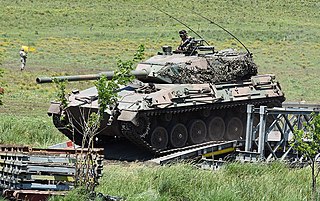
The Tanque Argentino Mediano is a medium tank in service with the Argentine Army. Lacking the experience and resources to design a tank, the Argentine Ministry of Defense contracted German company Thyssen-Henschel. The vehicle was developed by a German and Argentine team of engineers, and was based on the German Marder infantry fighting vehicle chassis.

The T95 was an American prototype medium tank developed from 1955 to 1959. These tanks used many advanced or unusual features, such as siliceous-cored armor, new transmissions, and OPTAR fire-control systems. The OPTAR incorporated an electro-optical rangefinder and was mounted on the right side of the turret, and was used in conjunction with the APFSDS-firing 90 mm T208 smoothbore gun, which had a rigid mount without a recoil system. In addition, although the tanks were designed with a torsion beam suspension, a hydropneumatic suspension was fitted, and one of the tanks was fitted with a Solar Saturn gas turbine for demonstration purposes.
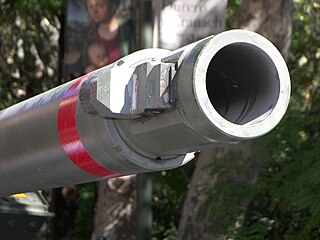
The Rheinmetall Rh-120 is a 120 mm smoothbore tank gun designed and produced in former West Germany by the Rheinmetall Waffe Munition GmbH company, it was developed in response to Soviet advances in armour technology and development of new armoured threats. Production began in 1974, with the first version of the gun, known as the L/44 as it was 44 calibres long, used on the German Leopard 2 tank and soon produced under license for the American M1A1 Abrams and other tanks. The 120-millimetre (4.7 in) gun has a length of 5.28 metres (17.3 ft), and the gun system weighs approximately 3,317 kilograms (7,313 lb).
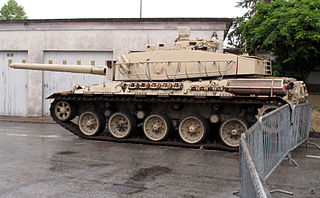
The AMX-32 was a French main battle tank developed by AMX and APX in the late 1970s during the Cold War as an export tank to fit in a specific market niche of nations with smaller defence budgets. While six prototypes were built, it failed to garner interest for foreign sales.
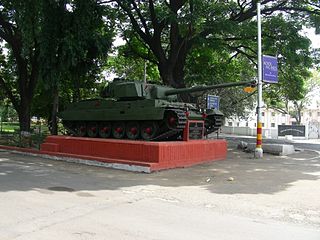
The Vickers MBT is a series of main battle tanks (MBTs) developed as a private venture by British company Vickers-Armstrongs for export. The design makes use of proven components, such as the L7 gun of the Centurion, the Leyland L60 multi-fuel engine, the transmission and fire control system of the Chieftain. Many copied tanks were also built by India under licence as the Vijayanta.

The Type 80 and the Type 88 are a family of Chinese second-generation main battle tanks (MBTs). They are also known as the ZTZ80 and ZTZ88.
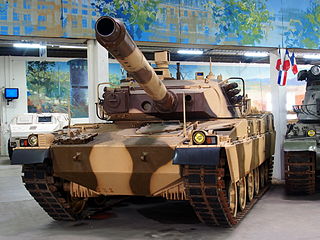
The AMX-40 was a French main battle tank developed by GIAT during the latter stages of the Cold War as an export tank to replace the earlier AMX-32. Designed to be an inexpensive tank orientated towards militaries with smaller defence budgets, the AMX-40 featured a lightly armoured hull and good mobility reminiscent of previous French MBTs with a powerful 120 mm cannon. It however failed to attract interest and sales, rendering the project a failure, being discontinued in 1990.

The Royal Ordnance L11A5, officially designated Gun, 120 mm, Tank L11, is a 120 mm L/55 rifled tank gun design. It was the second 120 mm calibre tank gun in service with British Army. It was the first of NATO's 120 mm main battle tank guns which became the standard calibre for Western tanks in the later period of the Cold War. A total of 3,012 of the L11 guns were produced by 2005. The list price was US$227,000 in 1990.

The OF-40 is an Italian main battle tank developed as a joint venture between OTO Melara and Fiat, and intended primarily for export sales. OTO Melara would develop and produce the hulls, and automotive components would be provided by Fiat. Initial design work was started by OTO Melara in 1977, with the first prototypes ready by 1980.

The post–Cold War era is the period in world history from the collapse of the Soviet Union on December 27, 1991 to the present. During the Cold War, the Soviet domination of the Warsaw Pact led to effective standardization on a few tank designs. In comparison, France, Germany, the United States, and the United Kingdom had previously developed their own tank designs, but now tried to standardize their designs, while the smaller nations of NATO purchased or adapted these designs.

The FV4601 MBT-80 was a British experimental third-generation main battle tank, designed in the late 1970s to replace the Chieftain tank. It was eventually cancelled in favour of the Challenger 1, itself an evolution of the Chieftain design.

The Type 59G Durjoy, sometimes known as Type 59G, is a highly modernized version of the Chinese Type 59 tank for the Bangladesh Army. The Bangladesh Army's old Type 59 tanks were upgraded similarly to Type 59G standard at 902 Central Workshop of the Bangladesh Machine Tools Factory with Chinese assistance.
The Vickers Main Battle Tank Mk. 4 later known as the Vickers Valiant was a main battle tank developed as a private venture by British company Vickers for export. Its development began in 1976 and ended in January 1984. Although the Valiant did not enter production, its development provided valuable experience in the production of an aluminium-hulled, Chobham-armoured tank in the 40 tonnes weight range. A further development of its turret was later used for the Vickers Mk. 7 MBT.

The Vickers Main Battle Tank Mk. 3 is a main battle tank by Vickers, a development of the Vickers MBT, and introduced in 1975 for the export market. It was the last of the Vickers tanks to see sales in numbers abroad.


















